Sini (script)
Sini (from Arabic: صيني, Ṣīnī, "Chinese") is a calligraphic style used in China for the Arabic script. It can refer to any type of Chinese Arabic calligraphy, but is commonly used to refer to one with thick and tapered effects such as seen in Chinese calligraphy. It is used extensively in mosques in Eastern China and to a lesser extent in Gansu, Ningxia and Shaanxi.
| Part of a series on Islam in China | ||||||
|---|---|---|---|---|---|---|
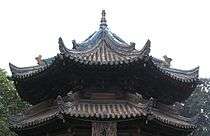 | ||||||
|
||||||
|
| ||||||
One famous Sini calligrapher is Hajji Noor Deen Mi Guangjiang.
| Calligraphy |
|---|
Gallery
 The names of Allah in Chinese Arabic Sini Script
The names of Allah in Chinese Arabic Sini Script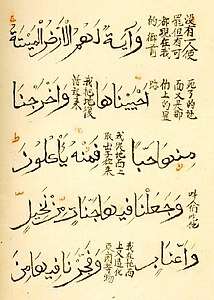 Chinese Qur'an
Chinese Qur'an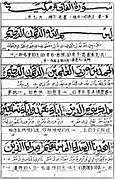 Quran with Chinese translation recorded in both Arabic script of Xiao'erjing and Chinese scripts
Quran with Chinese translation recorded in both Arabic script of Xiao'erjing and Chinese scripts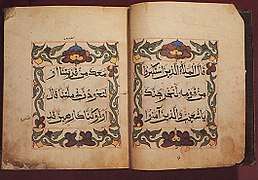 Qur'anic Manuscript in Sini script
Qur'anic Manuscript in Sini script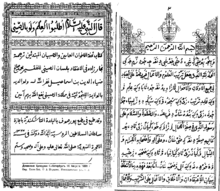 An Arabic book on Islamic ritual, with a parallel Chinese translation in the Xiao'erjing Arabic script, published in Tashkent in 1899
An Arabic book on Islamic ritual, with a parallel Chinese translation in the Xiao'erjing Arabic script, published in Tashkent in 1899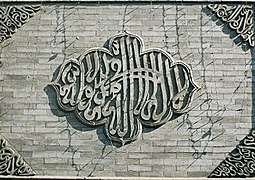 Calligraphy on a plaque in the Great Mosque of Xi'an in Sini script
Calligraphy on a plaque in the Great Mosque of Xi'an in Sini script An example of the Sini script
An example of the Sini script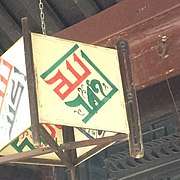 Taḥmīd ("Praise be to God") in Arabic Ṣīnī-style calligraphy at the Great Mosque of Xi'an
Taḥmīd ("Praise be to God") in Arabic Ṣīnī-style calligraphy at the Great Mosque of Xi'an
gollark: Maybe?
gollark: Well, if all the child murderers are Republican, that does make it sound like there's an issue.
gollark: It's not confirmation bias, that's selection bias.
gollark: People are generally *kind of bad*.
gollark: I'm not sure about that.
See also
- Islamic calligraphy
- Chinese calligraphy
- Xiao'erjing: the use of Arabic script for writing Chinese language
External links
- Islamic Calligraphy in China, China Heritage Newsletter, Number 5 (March 2006)
- Hajji Noor Deen's Website, features Sini galleries
- Islamic Chinese Art (Dru C. Gladney's photo album on Flickr.com)
This article is issued from Wikipedia. The text is licensed under Creative Commons - Attribution - Sharealike. Additional terms may apply for the media files.
